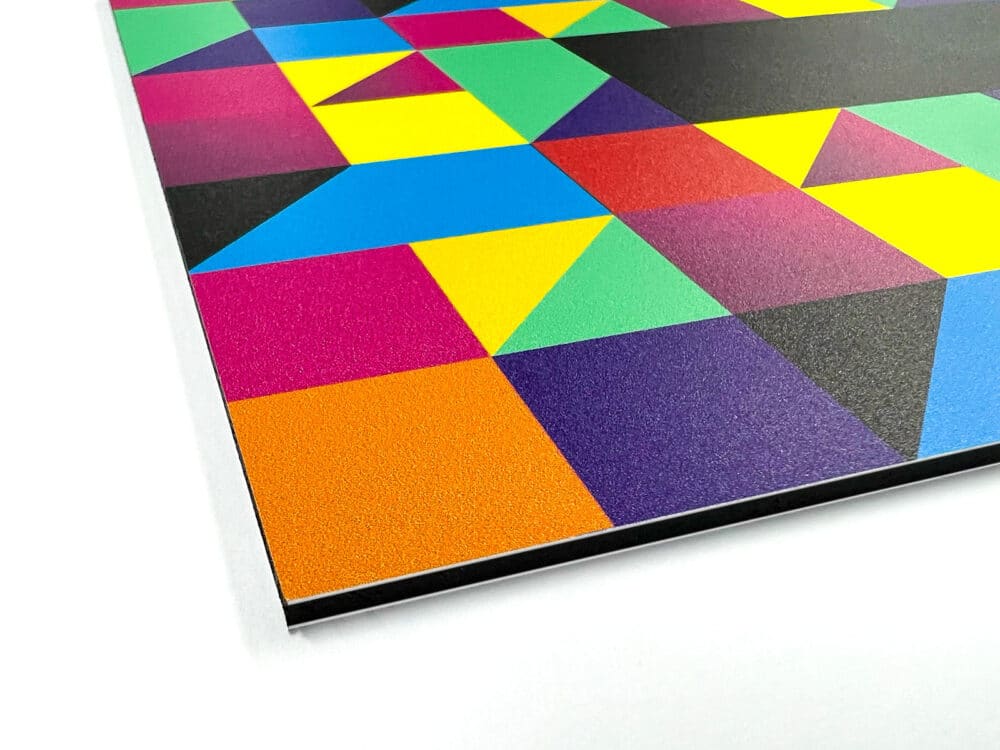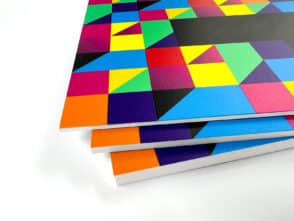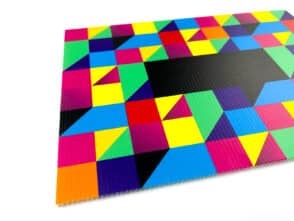Dibond printing offers an innovative solution for businesses seeking long-lasting and visually appealing signage. Made from aluminium composite material, Dibond signs are incredibly durable, weather-resistant, and perfect for both indoor and outdoor use. Dibond panels consist of a polyethylene core sandwiched between two layers of aluminium, providing both strength and a sleek appearance. This makes it an excellent choice for various applications, from business signage to art displays.
A unique feature of Dibond signs is their lightweight nature, unlike traditional, heavier metals like steel. They are resilient to corrosion, ensuring they remain bright and functional for many years. Dibond boards are available in different sizes and thicknesses, with a common option being 3mm white aluminium, suitable for high-quality, single-sided printing. These characteristics make Dibond a favourite for those aiming to maximise their investment in signage.
Another reason to consider Dibond printing is its versatility in design. Whether you need custom sizes or unique print finishes, Dibond panels provide the flexibility and high-quality output that many professional settings require. With its ability to maintain vivid colours and clear images, it stands out as a premier choice for creating impactful and lasting impressions through signage.
Key Takeaways
- Dibond signs are made from durable aluminium composite material.
- They are lightweight, weather-resistant, and suitable for indoor and outdoor use.
- Dibond printing offers versatility in size, design, and high-quality output.
What Is Dibond?
Dibond is a lightweight, strong material that is ideal for various applications, especially in signage and printing. It mainly consists of aluminium composite sheets and a polyethylene core.
Composition and Materials
Dibond is made up of three layers. It has two thin aluminium sheets on the outside and a black polyethylene core in the middle. The aluminium layers are coated, providing a smooth and durable surface. This design makes Dibond a lightweight yet strong material. The polyethylene core adds flexibility and strength while keeping the weight down.
This structure also gives Dibond its weather-resistant properties. The aluminium layers protect against corrosion and weather conditions, and the polyethylene core helps maintain its shape even in extreme temperatures.
Applications and Uses
Dibond is highly versatile and used in multiple areas. It’s popular for outdoor and indoor signage because it’s weather and corrosion-resistant. The smooth surface allows for high-quality printing, making it ideal for advertisements and information displays.
In the art world, Dibond is used for photo printing. Pictures are printed directly onto the material, resulting in a robust, long-lasting print that can withstand various conditions. Dibond can also be used in exhibition displays, shop fittings, and even decorative pieces due to its sleek and modern appearance.
Moreover, it’s easy to cut, shape, and drill, which simplifies its use in custom applications. This makes Dibond a favourite among designers and manufacturers for a variety of projects.
Dibond Printing Techniques
Dibond printing methods ensure high-quality, durable prints suitable for various applications. Key aspects include the digital printing process, colour, resolution considerations, and prepress stage essentials.
Digital Printing Process
Dibond printing primarily uses digital techniques due to their efficiency and quality. Digital printing involves directly applying inks onto the aluminium substrate, ensuring quick turnaround times and cost-effectiveness. The surface of Dibond is polyester lacquered, making it ideal for both screen and digital printing. This smooth surface enables precise ink adhesion, resulting in a clear and vibrant image.
Colour and Resolution Considerations
Colour and resolution are crucial for high-quality Dibond prints. Using a 7-colour printing method can produce rich, saturated hues. This process enhances the vibrancy and depth of colours, especially in large monochrome areas. High resolution ensures detailed and sharp images, beneficial for fine lines and intricate designs. Proper calibration of printers ensures accurate colour matching and consistency across prints.
Prepress Stage Essentials
Before printing, several steps in the prepress stage are essential. Preparing the artwork involves adjusting line weight and ensuring the correct resolution. Files must be checked for colour accuracy and any potential printing issues. Properly setting up the print file helps in achieving the best possible outcome. Ensuring all elements are aligned and within safe zones prevents unwanted cropping or distortion.
Designing for Dibond
Designing for Dibond printing requires careful planning to ensure the best results. This includes optimising the artwork for print and setting up the correct file formats to accommodate the material’s unique properties.
Optimising Artwork for Print
When designing for Dibond, consider the properties of this aluminium composite material. The printed artwork must account for cutting lines and custom shape boards. Ensure there is enough bleed to avoid white edges after cutting.
Among the recommended practices:
- Resolution: Use high-resolution images (300 dpi) to achieve sharp results.
- Bleed and Trim: Add a 3-5 mm bleed to the artwork to guarantee no unprinted edges.
- Cutting Lines: Clearly mark any cutting lines to guide the production process.
- Custom Shapes: For custom shapes, outline the desired shape using vector paths and clearly label these paths.
Listing items such as size positions (A0, A1, A2, A3, A4) helps in maintaining precision.
File Format and Setup
Correct file setup is crucial for successful Dibond printing. The artwork should be provided in a print-ready format, typically a PDF. The file should be split into a 2-page PDF if the design has a front and back.
When preparing the file:
- Colour Mode: Use CMYK colour mode for accurate colour reproduction.
- File Types: Save files in PDF or EPS. Ensure all fonts are converted to curves.
- Layers: Include various layers appropriately named for top layer, middle layer, and bottom layer if you are representing different sections.
- Personalised Elements: Ensure that any personalised elements are correctly placed and clearly identifiable.
It’s important that the files are easy to interpret by the printing service to avoid any errors and achieve the intended look.
Physical Characteristics of Dibond Signs
Dibond signs are made from a combination of materials that result in a strong, lightweight, and weather-resistant product. These signs offer various finish options and are easy to maintain.
Durability and Weather Resistance
Dibond signs are known for their impressive durability. Made from two thin aluminium sheets with a polyethylene core, these signs are both rigid and lightweight. This composite material construction provides excellent resistance to weather conditions.
They are weather-resistant, able to withstand UV light, rain, and other environmental factors without degrading. Additionally, these signs are water-resistant, ensuring they do not rust or suffer water damage. The protective film layer on Dibond signs further enhances their lifespan by safeguarding against scratches and external damage.
Finish Options and Maintenance
Dibond signs are available with various finish options. Common finishes include matt lamination and glossy finishes, which add an extra layer of protection. Some signs even come with a dry-wipe surface, making them easy to clean and reset.
Maintaining Dibond signs is straightforward. Thanks to the protective film and finish, they require minimal upkeep. Regular cleaning with mild soap and water is usually sufficient. For tougher stains, a non-abrasive cleaner can be used without damaging the sign panel. These features make Dibond signs a practical choice for long-term indoor and outdoor signage.
Installation and Mounting
Proper installation and mounting of Dibond prints ensure stability and enhance visual appeal. Key considerations include the correct tools and techniques for mounting and the specific requirements for indoor and outdoor signage.
Methods and Tools
Dibond mounting often involves several methods, including using brackets, standoffs, or adhesives. For each method, drill holes are frequently needed. Drilling through the composite aluminium requires precision to avoid damaging the print or the material.
Tools needed:
- Drill
- Sanding sponge
- Screws
- Measuring tape
After drilling, smoothing the edges with a sanding sponge prevents any jagged ends that could harm the print or wall. Double-sided prints may require special mounting to ensure both sides are visible, often using transparent standoff screws.
Indoor and Outdoor Signage Considerations
Indoor installations benefit from the lightweight nature of Dibond, making it suitable for a wide variety of display sizes without causing stress to the walls. Maintaining an even, flat mount is essential to avoid bowing.
For outdoor signs, Dibond’s waterproof and durable qualities are critical. The material withstands weather conditions without deteriorating, making it a reliable choice for outdoor signage. Ensuring that the mounting solution also provides weather resistance is important.
When considering the location, one must factor in the double-sided print visibility to maximise the display’s impact. Additionally, drilled holes need to be sealed appropriately to prevent water ingress in outdoor settings.
Frequently Asked Questions
Dibond printing offers durability and quality for both indoor and outdoor displays. Here are some commonly asked questions about this versatile material.
How much does it generally cost to produce a print on Dibond material?
Costs for Dibond printing can vary based on the size of the print and the complexity of the design. Typically, it’s more expensive than materials like Foamex or Correx due to its durability and long-lasting quality.
Where can one find professional Dibond printing services?
Professional Dibond printing services are available from various print specialists across the UK. Companies like Banner World offer custom Dibond printing.
What are the typical dimensions and pricing for Dibond sheets?
Dibond sheets come in standard sizes, including 3mm and 4mm thicknesses. The dimensions can range widely, with common sizes being 1220mm x 2440mm. Pricing can depend on size and thickness, so it’s best to check with specific suppliers for exact quotes.
Can you describe the process and benefits of aluminium Dibond printing?
Aluminium Dibond printing involves direct printing onto the aluminium composite material, which consists of two aluminium layers and a polyethylene core. This creates a lightweight yet strong board. The benefits include high durability, rust resistance, and the ability to produce high-resolution, vibrant prints.
Are Dibond prints resistant to outdoor weather conditions?
Yes, Dibond prints are highly resistant to outdoor weather conditions. They can withstand temperatures from minus 50°C to plus 80°C, making them suitable for various climates. Additionally, they resist rust, fading, and UV light, ensuring long-term durability.
In what way can custom signs be created using Dibond?
Custom signs using Dibond can be created through various printing and cutting techniques. The material’s rigidity allows for precise shaping and cutting. This makes it ideal for creating bespoke signs that maintain structural integrity and visual appeal over time.






You must be logged in to post a review.